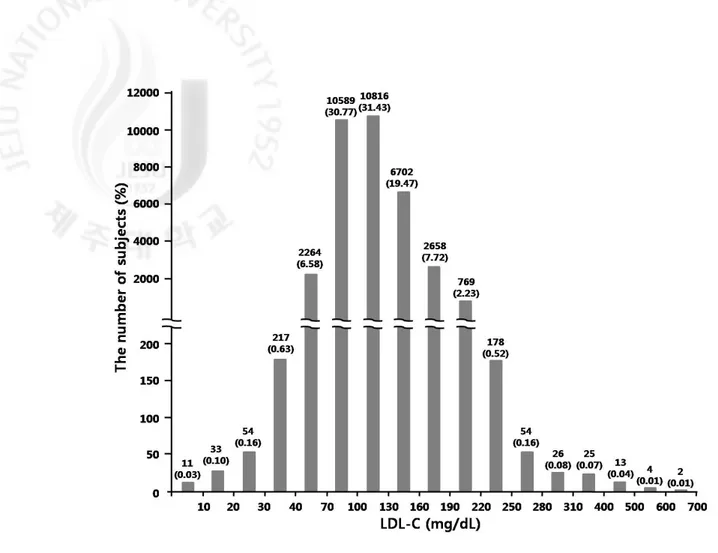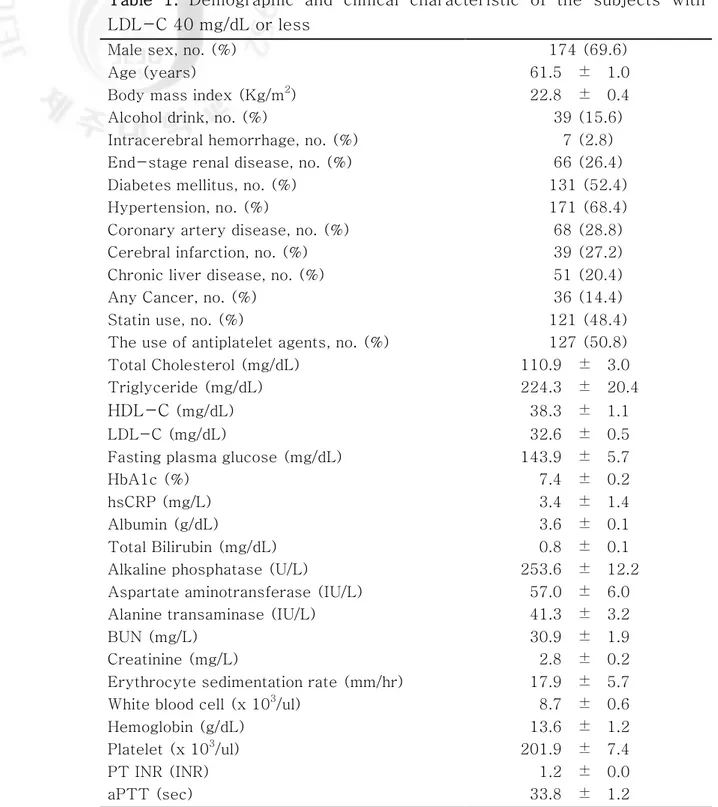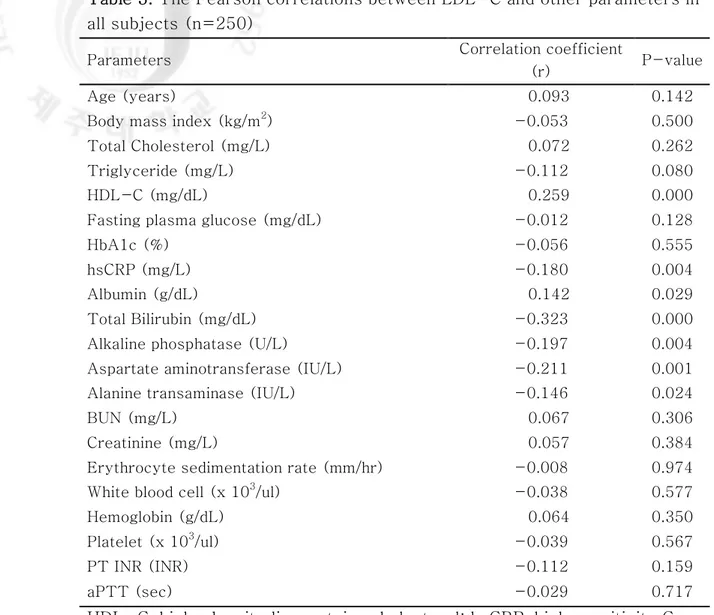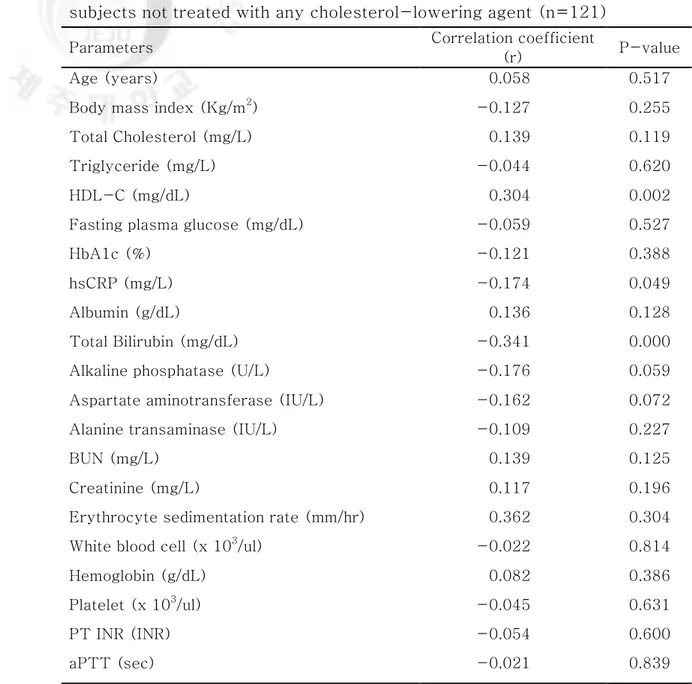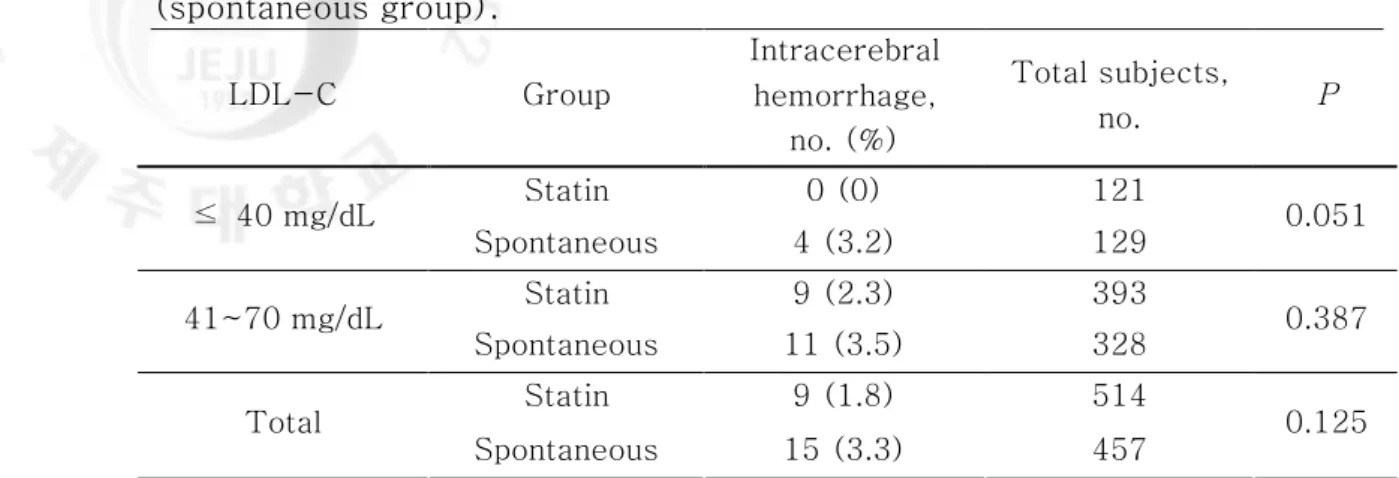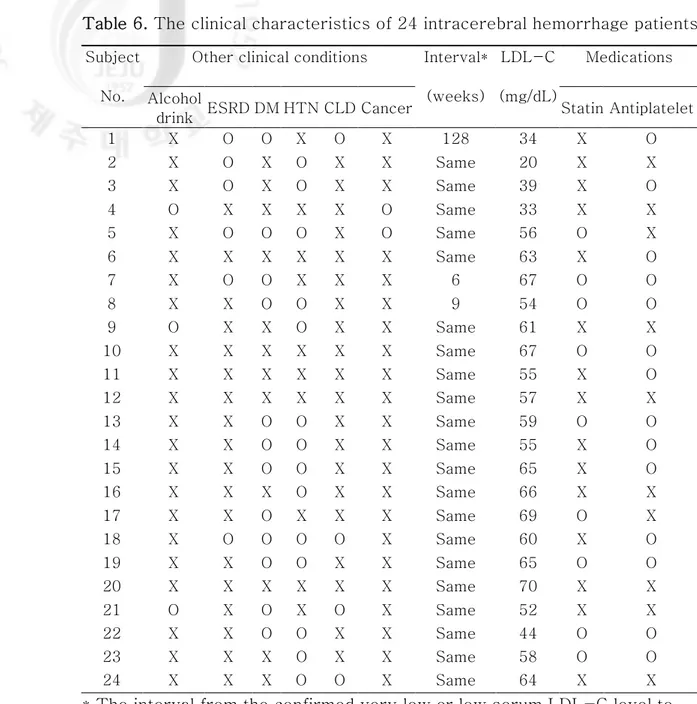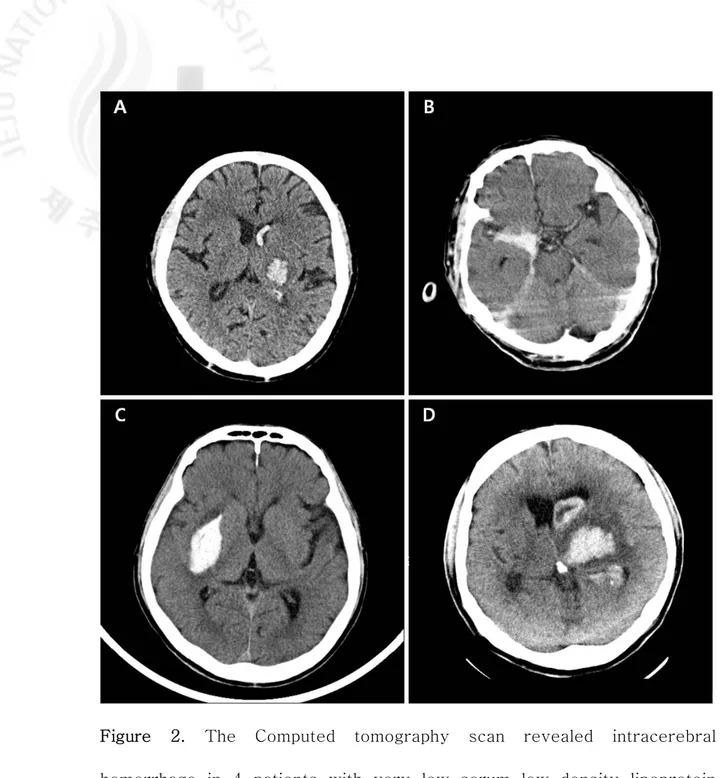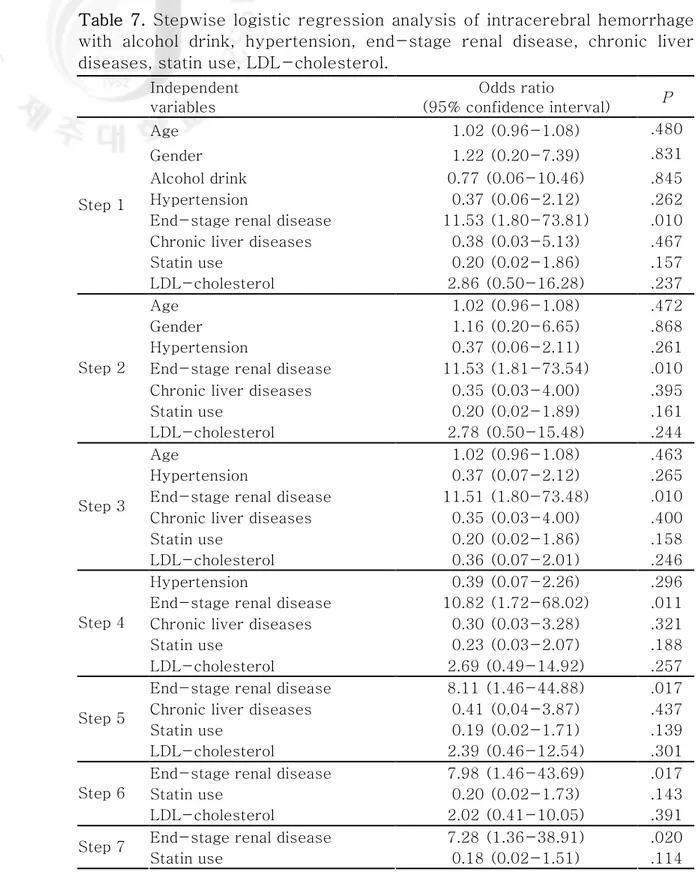저작자표시-비영리-변경금지 2.0 대한민국 이용자는 아래의 조건을 따르는 경우에 한하여 자유롭게 l 이 저작물을 복제, 배포, 전송, 전시, 공연 및 방송할 수 있습니다. 다음과 같은 조건을 따라야 합니다: l 귀하는, 이 저작물의 재이용이나 배포의 경우, 이 저작물에 적용된 이용허락조건 을 명확하게 나타내어야 합니다. l 저작권자로부터 별도의 허가를 받으면 이러한 조건들은 적용되지 않습니다. 저작권법에 따른 이용자의 권리는 위의 내용에 의하여 영향을 받지 않습니다. 이것은 이용허락규약(Legal Code)을 이해하기 쉽게 요약한 것입니다. Disclaimer 저작자표시. 귀하는 원저작자를 표시하여야 합니다. 비영리. 귀하는 이 저작물을 영리 목적으로 이용할 수 없습니다. 변경금지. 귀하는 이 저작물을 개작, 변형 또는 가공할 수 없습니다.
1
의학석사 학위논문
혈청 LDL 콜레스테롤이 낮은 환자의 임상적
특징과 뇌출혈 발생 위험도
The Characteristics of the Subjects with Very
Low Serum Low Density Lipoprotein
Cholesterol and the Risk of Intracerebral
Hemorrhage in Those Subjects
2012년 2월
제주대학교 대학원
의학과
이 재 근
2
혈청 LDL 콜레스테롤이 낮은 환자의 임상적
특징과 뇌출혈 발생 위험도
지도교수 이대호
이재근
이 논문을 의학석사 학위논문으로 제출함
2012년 2월
이재근의 의학석사 학위 논문을 인준함.
2012년 2월
심사 위원장 (印)
부 위 원 장 (印)
위 원 (印)
제주대학교 대학원
3
2012 년 2 월
The Characteristics of the Subjects with Very Low
Serum Low Density Lipoprotein Cholesterol and the
Risk of Intracerebral Hemorrhage in Those Subjects
Jae-Geun Lee
(Supervised by professor Daeho Lee)
A thesis submitted in partial fulfillment of the requirement for
the degree of Master in medicine
( Department of Internal Medicine)
In Jeju National University, Jeju, Korea
February, 2012
This thesis has been examined and approved.
Doctoral Committee:
Professor Chairman
Professor Vice chairman
Professor
4
GRADUATE SCHOOL
JEJU NATIONAL UNIVERSITY
5
Abstract
Aims : Further studies about hypocholesterolemia are warranted. Some studies revealed an association between hypocholesterolemia and intracerebral hemorrhage (ICH). In the present study, we aimed to evaluate the clinical characteristics of the subjects with very low serum low density lipoprotein cholesterol (LDL-C) and compare the risk of ICH by statin use or statin non-use group in the subjects.
Methods : From our hospital records, we evaluated the clinical characteristics of subjects with LDL-C £ 40 mg/dL. The exclusion criteria were systemic infectious or inflammatory diseases, trauma, brain tumor, type 1 diabetes, acute systemic illness, pregnancy, thrombolytic therapy in the hospital when the lipid profiles were measured.
Results : Among a total of 34415 subjects who were presented to the laboratory to measure serum LDL-C, 250 subjects had serum LDL-C 40 mg/dL or less that we defined as very low level. Nearly half of the subjects had very low LDL-C level without history of statin use, usually due to alcohol intake or various chronic illnesses including liver diseases, end stage renal disease (ESRD). ICH occurred in 4 subjects with very low LDL-C, all of whom had no history of statin use. Among various clinical factors, ESRD was related with ICH in subjects with very low LDL-C.
6
Conclusions : We found about 1% of subjects whose LDL-C was measured in a hospital have LDL-C 40mg/dL or less. Among them, half of the subjects had no history of hypolipidemic therapy. ICH incidence tended to be higher in this spontaneous group than in statin users.
Key words: Hypocholesterolemia, LDL cholesterol, Statin, Intracerebral hemorrhage
7
Introduction
During the last generation, there have been remarkable progressions in lipid-lowering therapy, especially with the development of potent statins. Although intensive lipid-lowering therapy has contributed significantly in the primary and secondary prevention of cardiovascular diseases (CVD), the large residual risk of CVD is a major limitation 1). To overcome this
problem, further studies about various combination regimens and new therapeutic strategies are ongoing. The other issue is that the lower limit to safe and effective cholesterol lowering has not been established. Some experts suggested that a plasma level of 25 mg/dL LDL-cholesterol (LDL-C) would be sufficient to supply peripheral cholesterol needs 2). Actually, plasma LDL-C level in human newborns has been reported to be in the range of 40-50 mg/dL 3). To determine the lowest LDL-C level that we may reach therapeutically without any harm, further studies about the clinical state of low serum LDL-C are warranted.
Low serum total cholesterol (TC) level as well as high TC level has been reported to be associated with increased mortality, a U- or J-shaped relationship 4,5). Whereas the increased CVD is major cause of death at high
TC concentration, non-atherosclerotic causes, including cancer,
hemorrhagic stroke, and liver disease are related with the increased mortality at low TC level 6,7). When deaths during the first several years of follow-up were excluded, only the association between low TC and
8
hemorrhagic stroke remained in a 23-year prospective cohort study 5).
High blood pressure (BP) and alcohol drinks among various clinical factors increase the risk of hemorrhagic stroke in subjects with low TC 5,8). Most of guidelines for the treatment of hypercholesterolemia recommend LDL-C level less than 70 mg/dL in patients with very high risk for CVD 2,9).
Sometimes intensive therapeutic strategy leads to a very low LDL-C, 40 mg/dL or less, in statin-treated subjects. In many clinical trials of intensive statin treatment, however, the increased incidence of intracerebral hemorrhage (ICH) has not been confirmed 10-14). The Stroke Prevention by
Aggressive Reduction in Cholesterol Levels (SPARCL) trial showed an increase of ICH in subjects who treated with 80 mg atrovastatin after recent (within 1 to 6 months) stroke or transient ischemic attack 15).
However, no relation was found between risk of ICH and baseline or recent LDL-C level in the statin-treated patients 16).
Hypocholesterolemia may be defined as serum total cholesterol that is lower than the 5th percentile for age and sex, or the cut-off value which predicts the adverse prognosis by epidemiological study 17). The 5th percentile of TC for male in USA is in the range of 131~154 mg/dL, while the 5th percentile of LDL-C in western countries is about 90 mg/dL 18).
Although hypocholesterolemia is not uncommon, it is frequently overlooked. Its prevalence varies according to populations and reaches 2-3% in general population and 6.2% in hospitalized patients at the department of internal medicine 19). And, data are lacking on the clinical meaning of the very low
9
serum level of LDL-C. Further researches about very low LDL-C status of primary and secondary origins may lead to an important clinical implication in guiding hypolipidemic therapy. In the present study, we aimed to evaluate the clinical characteristics of the subjects with a very low serum LDL-C via a hospital-based retrospective database analysis and compare the risk of ICH by statin use or statin non-use group.
10
Materials and Methods
We searched electronic hospital records on subjects who visited during the period from January, 2005 to March, 2011 Jeju National University Hospital and were subjected to routine biochemical tests, lipid profiles including LDL-C, body anthropometry, and vital sign assessments. We selected primarily subjects whose LDL-C 40 mg/dL or less. When we compared the risk of ICH according to serum LDL-C level, we collected limited clinical data from subjects with LDL-C between 41 and 70 mg/dL. The exclusion criteria are as follows: patients with systemic infectious or inflammatory diseases, trauma, primary or secondary brain tumor, type 1 diabetes, and acute systemic illness; pregnant subjects; patients who received thrombolytic therapy during the hospitalization when the lipid profiles were measured.
Hypertension was defined as anti-hypertensive drug use, systolic BP ³ 140 mmHg, or diastolic blood pressure ³ 90 mmHg. End stage renal disease (ESRD) was defined as the use of renal replacement therapy with Modification of Diet in Renal Disease-estimated glomerular filtration rate (eGFR) < 30 mL/min/1.73 m2. Obesity was defined as body mass index ³ 30 kg/m2. Diabetes mellitus was defined as insulin or oral anti-diabetic agent
use, or diagnosed according to American diabetes association guideline. Chronic liver disease was defined as chronic viral hepatitis or alcoholic liver disease. We defined alcohol drink as two or more drinks in a week. Stroke
11
was defined as a neurologic deficit lasting longer than 24 hours. Computed tomographic or magnetic resonance imaging of the brain was reviewed in all stroke cases. Lipids [total cholesterol (TC), triglycerides (TG), HDL cholesterol (HDL-C), LDL-C)] were measured by direct methods on an automated biochemical analyzer (TBA- 200FR NEO, Toshiba Medical Systems; Tokyo, Japan) using Determiner-L TC-II, TG-II, HDL-C and LDL-C (Kyowa Medex Co.,LTD; Tokyo, Japan).
The study protocol was reviewed and approved by the institutional review board (IRB No. #2011-46).
Statistical analysis
Statistical analyses were performed using SPSS version 18.0 for Windows (SPSS, Inc., Chicago, IL, USA). Student t tests with equal variance were used to determine significant differences of the means of normally distributed continuous variables (i.e., age) between groups. For nonparametric data, the Mann-Whitney U tests were used. The Pearson correlations between LDL-C and other variables were also calculated. A comparison of the incidence of ICH between subgroups was performed using a Fisher exact test. Stepwise regression test was also performed to calculate the relationships between ICH and various risk factors. Statistical significance was taken at an α level = 0.05 (P < 0.05) with associated 95% CI. Data are presented as mean ± SE.
13
Results
The hospital records revealed that 34415 subjects were subjected to measure LDL-C from January, 2005 to March, 2011. Serum LDL-C level was at a wide range between 2 and 692 mg/dL (Fig. 1). And, the median (25th, 75th percentile) serum LDL-C concentration was 109 (85, 135). Serum LDL-C was 70 mg/dL or less in 2579 subjects and 40 mg/dL or less in 315 subjects. We excluded 1608 subjects according to the exclusion criteria. Then, a total of 971 subjects were included in the present whose serum LDL-C was 70 mg/dL or less. We divided them into two groups: subjects with very low serum LDL-C (£ 40 mg/dL, n = 250) and subjects with low serum LDL-C (41-70 mg/dL, n = 721). We focused our analysis on subjects with very low LDL-C.
14
Figure 1. The distribution of LDL-C in the subjects 34415 subjects who were subjected to measure LDL-C from January, 2005 to March, 2011. Note that the LDL-C intervals of X-axis were set differently for less frequent and extreme values
15
The characteristics of the subjects with very low serum LDL-C
Table 1 shows the demographic and clinical characteristics of the subjects with serum LDL-C 40 mg/dL or less. The mean age of the subjects was 61.5 years. About 70% of the subjects with very low serum LDL-C were male. More than half and 2/3 subjects had diabetes and hypertension, respectively. These indicated that more patients with cardiometabolic disease and/or CVD were subjected to serum LDL-C measurement in the hospital. About half the subjects with very low LDL-C were current statin users.
In addition, significant proportions of subjects have one of chronic diseases: CKD in 66 subjects (26.4%), cerebral infarction in 39 subjects (27.2%), liver diseases in 51 subjects (20.4%), malignancy in 36 subjects (14.4%). With regard lipid profiles, despite of marked decrease in LDL-C, mean serum TG was relatively high (224.3 ± 20.4 mg/dL). Our result indicated that in these old subjects who measured LDL-C in a university hospital, nearly half of the subjects with very low LDL-C were statin users, whereas more than half had other causes.
16
Table 1. Demographic and clinical characteristic of the subjects with LDL-C 40 mg/dL or less
Male sex, no. (%) 174 (69.6)
Age (years) 61.5 ± 1.0
Body mass index (Kg/m2) 22.8 ± 0.4 Alcohol drink, no. (%) 39 (15.6) Intracerebral hemorrhage, no. (%) 7 (2.8) End-stage renal disease, no. (%) 66 (26.4) Diabetes mellitus, no. (%) 131 (52.4) Hypertension, no. (%) 171 (68.4) Coronary artery disease, no. (%) 68 (28.8) Cerebral infarction, no. (%) 39 (27.2) Chronic liver disease, no. (%) 51 (20.4) Any Cancer, no. (%) 36 (14.4) Statin use, no. (%) 121 (48.4) The use of antiplatelet agents, no. (%) 127 (50.8) Total Cholesterol (mg/dL) 110.9 ± 3.0 Triglyceride (mg/dL) 224.3 ± 20.4
HDL-C (mg/dL) 38.3 ± 1.1
LDL-C (mg/dL) 32.6 ± 0.5 Fasting plasma glucose (mg/dL) 143.9 ± 5.7
HbA1c (%) 7.4 ± 0.2
hsCRP (mg/L) 3.4 ± 1.4
Albumin (g/dL) 3.6 ± 0.1 Total Bilirubin (mg/dL) 0.8 ± 0.1 Alkaline phosphatase (U/L) 253.6 ± 12.2 Aspartate aminotransferase (IU/L) 57.0 ± 6.0 Alanine transaminase (IU/L) 41.3 ± 3.2
BUN (mg/L) 30.9 ± 1.9
Creatinine (mg/L) 2.8 ± 0.2 Erythrocyte sedimentation rate (mm/hr) 17.9 ± 5.7 White blood cell (x 103/ul) 8.7 ± 0.6 Hemoglobin (g/dL) 13.6 ± 1.2 Platelet (x 103/ul) 201.9 ± 7.4
PT INR (INR) 1.2 ± 0.0
aPTT (sec) 33.8 ± 1.2
Data was expressed as mean ± SE. HDL-C, high-density lipoprotein-cholesterol; LDL-C, low-density lipoprotein-lipoprotein-cholesterol; hsCRP, high sensitivity C-reactive protein; PT INR, prothrombin time international normalized ratio ; aPTT, activated partial thromboplastin time
17
Comparisons of clinical characteristics between statin users and
subjects with spontaneous hypocholesterolemia
Subjects with very low LDL-C were divided into two subgroups according to the use of cholesterol-lowering agents. Because all of drug-treated subjects were on statin among various cholesterol-lowering agents, we defined these two group as statin user group (n=129) and spontaneous group (n=121)(Table 2). Compared with the statin users, the spontaneous group had lower mean age, body mass index (BMI), and serum level of HDL-C, LDL-C and albumin, and had higher serum TG level and longer prothrombin time (PT). More subjects in the spontaneous group than in statin user group have been drinking alcohol frequently (24.0 vs. 6.6%, p < 0.001) and had liver diseases (27.1 vs. 13.2%, p < 0.01). The stain user group was more likely to have cardiometabolic diseases and/or cardiovascular complications which might be an important reason to use statin and anti-platelet agents.
18
Table 2. Demographic and clinical characteristic of very low LDL-C (LDL-C ≤ 40 mg/dL) patients on statin therapy and patients not treated with any cholesterol-lowering agent (spontaneous group).
Statin (n=121) Spontaneous
(n=129) P Male sex, no. (%) 83 (68.6) 91 (70.5) 0.738 Age (years) 65.4 ± 1.2 57.8 ± 1.4 0.000 Body mass index (kg/m2) 23.5 ± 0.5 22.1 ± 0.5 0.040 Alcohol drink, no. (%) 8 (6.6) 31 (24.0) 0.000 Intracerebral hemorrhage, no. (%) 1 (0.8) 6 (4.7) 0.067 End-stage renal disease, no. (%) 30 (24.8) 36 (27.9) 0.577 Diabetes mellitus, no. (%) 72 (59.5) 59 (45.7) 0.029 Hypertension, no. (%) 100 (82.6) 71 (55.0) 0.000 Coronary artery disease, no. (%) 46 (38.0) 22 (17.1) 0.000 Cerebral infarction, no. (%) 26 (21.5) 12 (9.3) 0.007 Chronic liver disease, no. (%) 16 (13.2) 35 (27.1) 0.006 Any cancer, no. (%) 19 (15.7) 17 (13.2) 0.570 The use of antiplatelet agents, no. (%) 95 (78.6) 32 (24.8) 0.000 Total Cholesterol (mg/dL) 107.0 ± 3.2 114.5 ± 5.0 0.214 Triglyceride (mg/dL) 179.6 ± 22.4 266.9 ± 33.3 0.032 HDL-C (mg/dL) 42.7 ± 1.4 34.0 ± 1.6 0.000 LDL-C (mg/dL) 34.4 ± 0.6 30.9 ± 0.9 0.001 Fasting plasma glucose (mg/dL) 140.2 ± 7.6 147.5 ± 8.5 0.528 HbA1c (%) 7.6 ± 0.3 7.3 ± 0.3 0.505 hsCRP (mg/L) 0.9 ± 0.5 5.7 ± 2.6 0.084 Albumin (g/dL) 3.8 ± 0.7 3.5 ± 0.1 0.002 Total Bilirubin (mg/dL) 0.6 ± 0.0 1.0 ± 0.2 0.023 Alkaline phosphatase (U/L) 231.9 ± 17.5 271.8 ± 17.0 0.105 Aspartate aminotransferase (IU/L) 38.0 ± 3.2 74.7 ± 11.0 0.002 Alanine transaminase (IU/L) 34.5 ± 2.8 47.6 ± 5.5 0.038 BUN (mg/L) 28.6 ± 2.3 33.0 ± 3.1 0.257 Creatinine (mg/L) 2.7 ± 0.4 2.8 ± 0.3 0.853 Erythrocyte sedimentation rate (mm/hr) 16.4 ± 7.5 19.5 ± 9.1 0.792 White blood cell (x 10^3/ul) 8.1 ± 0.4 9.3 ± 1.1 0.333 Hemoglobin (g/dL) 14.6 ± 2.2 12.7 ± 1.2 0.424 Platelet (x 10^3/ul) 206.8 ± 6.6 197.6 ± 12.8 0.537 PT INR (INR) 1.1 ± 0.0 1.3 ± 0.0 0.000 aPTT (sec) 31.8 ±2.0 35.0 ± 1.4 0.171
Data was expressed as mean ± SE. HDL-C, high-density lipoprotein-cholesterol; LDL-C, low-density lipoprotein-lipoprotein-cholesterol; hsCRP, high sensitivity C-reactive protein; PT INR, prothrombin time international normalized ratio ; aPTT, activated partial thromboplastin time
19
Factors associated with very low serum LDL-C
We evaluated correlations between serum LDL-C and other factors in subjects with a very low LDL-C. High sensitivity C-reactive protein (hsCRP) (r=-0.180), total bilirubin (r=-0.323), alkaline phosphatase (ALP) (r=-0.197), aspartate aminotransferase (AST) (r=-0.211) and alanine transaminase (ALT) (r=-0.146) showed a negative correlation, whereas HDL-C (r=0.259), and albumin (r=0.142) showed a positive correlation with LDL-C in subjects with serum LDL-C 40 mg/dL or less (Table 3). Adjusted for all of the linear factors above mentioned in addition to age and sex on linear regression analysis, serum LDL-C correlated with total bilirubin (β = -0.265, P = 0.001).
When we evaluate correlations between serum LDL-C and other factors in subjects without history of hypolipidemic therapy, hsCRP, total bilirubin, and HDL-C remained significant (Table 4).
20
Table 3. The Pearson correlations between LDL-C and other parameters in all subjects (n=250)
Parameters Correlation coefficient
(r) P-value
Age (years) 0.093 0.142
Body mass index (kg/m2) -0.053 0.500 Total Cholesterol (mg/L) 0.072 0.262 Triglyceride (mg/L) -0.112 0.080 HDL-C (mg/dL) 0.259 0.000 Fasting plasma glucose (mg/dL) -0.012 0.128
HbA1c (%) -0.056 0.555
hsCRP (mg/L) -0.180 0.004
Albumin (g/dL) 0.142 0.029 Total Bilirubin (mg/dL) -0.323 0.000 Alkaline phosphatase (U/L) -0.197 0.004 Aspartate aminotransferase (IU/L) -0.211 0.001 Alanine transaminase (IU/L) -0.146 0.024
BUN (mg/L) 0.067 0.306
Creatinine (mg/L) 0.057 0.384 Erythrocyte sedimentation rate (mm/hr) -0.008 0.974 White blood cell (x 103/ul) -0.038 0.577 Hemoglobin (g/dL) 0.064 0.350 Platelet (x 103/ul) -0.039 0.567
PT INR (INR) -0.112 0.159
aPTT (sec) -0.029 0.717
HDL-C, high-density lipoprotein-cholesterol; hsCRP, high sensitivity C-reactive protein; PT INR, prothrombin time international normalized ratio ; aPTT, activated partial thromboplastin time
21
Table 4. The Pearson correlations between LDL-C and other parameters in subjects not treated with any cholesterol-lowering agent (n=121)
Parameters Correlation coefficient
(r) P-value
Age (years) 0.058 0.517
Body mass index (Kg/m2) -0.127 0.255 Total Cholesterol (mg/L) 0.139 0.119 Triglyceride (mg/L) -0.044 0.620
HDL-C (mg/dL) 0.304 0.002
Fasting plasma glucose (mg/dL) -0.059 0.527
HbA1c (%) -0.121 0.388
hsCRP (mg/L) -0.174 0.049
Albumin (g/dL) 0.136 0.128
Total Bilirubin (mg/dL) -0.341 0.000 Alkaline phosphatase (U/L) -0.176 0.059 Aspartate aminotransferase (IU/L) -0.162 0.072 Alanine transaminase (IU/L) -0.109 0.227
BUN (mg/L) 0.139 0.125
Creatinine (mg/L) 0.117 0.196
Erythrocyte sedimentation rate (mm/hr) 0.362 0.304 White blood cell (x 103/ul) -0.022 0.814
Hemoglobin (g/dL) 0.082 0.386
Platelet (x 103/ul) -0.045 0.631
PT INR (INR) -0.054 0.600
aPTT (sec) -0.021 0.839
HDL-C, high-density lipoprotein-cholesterol; hsCRP, high sensitivity C-reactive protein; PT INR, prothrombin time international normalized ratio ; aPTT, activated partial thromboplastin time
22
ICH incidence in subjects with very low and low serum LDL-C level
Because the risk of hemorrhagic stroke is reported to be increased in subjects with hypocholesterolemia, we analyzed the incidence of ICH in subjects with very low LDL-C. A total of 4 ICH cases were found in 250 subjects with very low LDL-C (Fig. 2); all of the ICH patients have no history of statin use. However, because of low number of ICH cases, there was only a marginal statistical difference between the statin group and spontaneous group (p=0.051). These results suggested that very low LDL-C after statin use does not lead to an increase in the risk of ICH compared with the subjects with spontaneous hypo-LDL-cholesterolemia. Then, we extended our search on ICH to the subjects with serum LDL-C level 70 mg/dL or less. We found out 20 additional ICH cases from 721 subjects whose serum LDL-C ranges from 41 to 70 mg/dL. The ICH incidence in the low LDL-C group (LDL-C level between 41 and 70) was 9 cases among 393 statin users compared with 11 cases in 328 subjects who had no history of hypolipidemic drug treatment (p = 0.387) (Table 5).When combined, a total of 24 ICH cases were available for the comparison between statin user and spontaneous group. There was also a tendency toward a higher incidence of ICH in spontaneous group (15 cases among 457 subjects) compared with statin user (9 cases among 514 subjects (p = 0.125). Various clinical characteristics of 24 ICH patients are summarized in Table 6.
23
Table 5. Incidence of intracerebral hemorrhage in subject with on statin therapy and in subjects not treated with any cholesterol-lowering agent (spontaneous group). LDL-C Group Intracerebral hemorrhage, no. (%) Total subjects, no. P Statin 0 (0) 121 ≤ 40 mg/dL Spontaneous 4 (3.2) 129 0.051 Statin 9 (2.3) 393 41~70 mg/dL Spontaneous 11 (3.5) 328 0.387 Statin 9 (1.8) 514 Total Spontaneous 15 (3.3) 457 0.125
24
Table 6. The clinical characteristics of 24 intracerebral hemorrhage patients
Other clinical conditions Medications Subject
No. Alcohol
drink ESRD DM HTN CLD Cancer
Interval* (weeks) LDL-C (mg/dL) Statin Antiplatelet 1 X O O X O X 128 34 X O 2 X O X O X X Same 20 X X 3 X O X O X X Same 39 X O 4 O X X X X O Same 33 X X 5 X O O O X O Same 56 O X 6 X X X X X X Same 63 X O 7 X O O X X X 6 67 O O 8 X X O O X X 9 54 O O 9 O X X O X X Same 61 X X 10 X X X X X X Same 67 O O 11 X X X X X X Same 55 X O 12 X X X X X X Same 57 X X 13 X X O O X X Same 59 O O 14 X X O O X X Same 55 X O 15 X X O O X X Same 65 X O 16 X X X O X X Same 66 X X 17 X X O X X X Same 69 O X 18 X O O O O X Same 60 X O 19 X X O O X X Same 65 O O 20 X X X X X X Same 70 X X 21 O X O X O X Same 52 X X 22 X X O O X X Same 44 O O 23 X X X O X X Same 58 O O 24 X X X O O X Same 64 X X
* The interval from the confirmed very low or low serum LDL-C level to incident intracerebral hemorrhage. ICH, intracerebral hemorrhage; ESRD, end-stage renal disease; DM, diabetes mellitus; HTN, hypertension; CLD, chronic liver diseases
25
Figure 2. The Computed tomography scan revealed intracerebral hemorrhage in 4 patients with very low serum low density lipoprotein cholesterol (LDL-C ≤ 40 mg/dL).
26
Factors associated with development of ICH in subjects with very low
LDL-C
To find out independent determinants of ICH, a multiple stepwise regression analysis was performed using data from subjects with very low LDL-C. In this analysis, LDL-C level was categorized into two nominal variables; LDL-C < 30mg/dL and LDL-C 31-40mg/dL. In addition to age and sex, the following parameters were included in the analysis: Alcohol drink, hypertension, ESRD, chronic liver disease, statin use, and LDL-C. Only ESRD was positively associated with the development of ICH (p=0.020) (Table 7).
27
Table 7. Stepwise logistic regression analysis of intracerebral hemorrhage with alcohol drink, hypertension, end-stage renal disease, chronic liver diseases, statin use, LDL-cholesterol.
Independent variables Odds ratio (95% confidence interval) P Age 1.02 (0.96-1.08) .480 Gender 1.22 (0.20-7.39) .831 Alcohol drink 0.77 (0.06-10.46) .845 Hypertension 0.37 (0.06-2.12) .262 End-stage renal disease 11.53 (1.80-73.81) .010 Chronic liver diseases 0.38 (0.03-5.13) .467 Statin use 0.20 (0.02-1.86) .157 Step 1 LDL-cholesterol 2.86 (0.50-16.28) .237 Age 1.02 (0.96-1.08) .472 Gender 1.16 (0.20-6.65) .868 Hypertension 0.37 (0.06-2.11) .261 End-stage renal disease 11.53 (1.81-73.54) .010 Chronic liver diseases 0.35 (0.03-4.00) .395 Statin use 0.20 (0.02-1.89) .161 Step 2
LDL-cholesterol 2.78 (0.50-15.48) .244
Age 1.02 (0.96-1.08) .463
Hypertension 0.37 (0.07-2.12) .265 End-stage renal disease 11.51 (1.80-73.48) .010 Chronic liver diseases 0.35 (0.03-4.00) .400 Statin use 0.20 (0.02-1.86) .158 Step 3
LDL-cholesterol 0.36 (0.07-2.01) .246 Hypertension 0.39 (0.07-2.26) .296 End-stage renal disease 10.82 (1.72-68.02) .011 Chronic liver diseases 0.30 (0.03-3.28) .321 Statin use 0.23 (0.03-2.07) .188 Step 4
LDL-cholesterol 2.69 (0.49-14.92) .257 End-stage renal disease 8.11 (1.46-44.88) .017 Chronic liver diseases 0.41 (0.04-3.87) .437 Statin use 0.19 (0.02-1.71) .139 Step 5
LDL-cholesterol 2.39 (0.46-12.54) .301 End-stage renal disease 7.98 (1.46-43.69) .017 Statin use 0.20 (0.02-1.73) .143 Step 6
LDL-cholesterol 2.02 (0.41-10.05) .391 End-stage renal disease 7.28 (1.36-38.91) .020 Step 7
28
Discussion
The causes of primary hypocholesterolemia are some disorders owing to genetic mutation in the pathway of cholesterol absorption, biosynthesis or metabolism, including abetalipoproteinemia, hypobetalipoproteinemia, Tangier disease, chylomicron retention disease and inherited disorders of cholesterol biosynthesis 18). The causes of secondary hypocholesterolemia
comprise anemia, hyperthyroidism, malignancy, chronic hepatitis B or C infection, other liver diseases, critical illness, serious stress, malabsorption or malnutrition, acute or chronic infection, chronic inflammation, and use of
some drugs 18). In addition, what's more important is that
hypocholesterolemia can result in some adverse events, although direct causal relationships were not clarified, such as increased mortality, intracerebral hemorrhage, cancer, infection, adrenal failure, and mental disorder 18,20-23). Therefore, with the practice of intensive lipid-lowering treatment and the tendency to the increased indications of statins, it's high time that physicians attached more importance to hypocholesterolemia 17,24,25).
In the present study, we evaluated the clinical characteristics of the subjects with very low LDL-C, the level of which we defined as serum LDL-C 40mg/dL or less. The reason why we choose this level of LDL-C was that intensive statin therapy could decrease serum LDL-C close to this level, in some patients, when indicated as in patients with a very high cardiovascular risk 13,26). In our study subjects with very low LDL-C, about
29
half of the subjects were statin user. To our surprise, the rest of subjects had very low LDL-C without statin or other hypolipidemic agents. In line with previous reports, we also observed a significant proportion of the subjects with a very low serum LDL-C had one or more chronic medical illnesses. More subjects with chronic liver disease or who drink alcohol frequently were in spontaneous very low LDL-C group than in statin user group.
There have been some concerns about an association between statin use and ICH 16). Some reported that a history of hypercholesterolemia and statin
use was associated decreased risk of ICH 27). There have been no definitive
evidence of an increased risk of ICH with the wide spread use of statins 27).
Furthermore, an increase in hemorrhagic stroke was not observed in the long-term statin secondary prevention trials that examined hemorrhagic stroke as a secondary end point 28-30). The incidence of hemorrhagic stroke
was £ 0.5% in both the placebo and statin-assigned groups.
A post hoc analysis of SPARCL trial showed that the risk of hemorrhagic stroke increased with high-dose atorvastatin treatment after recent stroke
16)
. Especially, having hemorrhagic stroke as the entry event increased the ICH risk, whereas the risk was not associated with post-treatment LDL-C level, even very low level (less than 40 mg/dL) 16). In German Diabetes and
Dialysis Study involving in patients with type 2 diabetes mellitus undergoing hemodialysis, more patients died of stroke in the atorvastatin group than in the placebo group 31). However, in that study, the fatal stroke was mainly
30
ischemic type; the incidence of fatal hemorrhagic stroke was tended to be lower in the atorvastatin group compared with placebo group 31). In the
present study, the incidence of hemorrhagic stroke tended to be higher in subjects with spontaneous LDL-C decrease compared with the subjects whose LDL-C was decreased by statin treatment. ESRD was a significant independent risk factor for ICH. And, our study also showed that ICH incidence did not further increase when LDL-C went down from low level to a very low level suggesting that post-statin LDL-C level is not associated with ICH.
Taken together, previous reports and our present data suggest that although low serum cholesterol level seems to be associated with hemorrhagic stroke, post-statin hypocholesterolemia is not associated with the development of hemorrhagic stroke. Rather, underlying condition may affect the development of hemorrhagic stroke in subject with low LDL-C. However, in subjects with hemorrhagic stroke at initial presentation, less aggressive therapy may be considered when statin is indicated 14).
This study has some limitations. First, the present data were collected retrospectively from hospital record only. Further cases of ICH might be missed. Second, we used direct LDL-C measurement data, not LDL-C calculated using the Friedewald formula. This led to a significant selection bias, because direct LDL-C measurements are not generally included lipid measurements. Actually our data usually came from the departments of internal medicine, neurology, neurosurgery, and rehabilitation. Third, the
31
demographic and clinical data of the subject without ICH whose LDL-C is between 41-70mg/dL are not included in the analysis. The primary goal of the present study was to evaluate the causes and clinical characteristics of a very low LDL-C status. We included ICH incidence in subject with low LDL-C for only comparison with the incidence of ICH in patients with a very low LDL-C. Our data showed that ICH incidence was not higher in subjects with LDL-C 40mg/dL or less than in subjects with LDL-C between 41 and 70 mg/dL. Fourth, our results were usually based on single measurement of LDL-C. LDL-C may change during acute to subacute stage of illnesses 18). Single point study can’t reflect the stage of illness.
In conclusions, in a hospital record review, we found about 1% of subjects whose LDL-C were measured have LDL-C 40mg/dL or less. And half of the subjects have such a low level of LDL-C without a history of hypolipidemic therapy and rather seem to have chronic systemic illnesses including viral hepatitis or alcoholic liver disease. ICH incidence tended to be higher in this spontaneous group than in statin users.
32
References
1. Cziraky MJ, Watson KE, Talbert RL. Targeting low HDL-cholesterol
to decrease residual cardiovascular risk in the managed care setting. J Manag Care Pharm 2008;14:S3-28; quiz S30-21.
2. Brunzell JD, Davidson M, Furberg CD, et al. Lipoprotein management in patients with cardiometabolic risk: consensus statement from the American Diabetes Association and the American College of Cardiology Foundation. Diabetes Care 2008;31:811-822.
3. O'Keefe JH, Jr., Cordain L, Harris WH, Moe RM, Vogel R. Optimal low-density lipoprotein is 50 to 70 mg/dl: lower is better and physiologically normal. J Am Coll Cardiol 2004;43:2142-2146.
4. Stemmermann GN, Chyou PH, Kagan A, Nomura AM, Yano K. Serum
cholesterol and mortality among Japanese-American men. The Honolulu (Hawaii) Heart Program. Arch Intern Med 1991;151:969-972.
5. Iribarren C, Reed DM, Burchfiel CM, Dwyer JH. Serum total cholesterol and mortality. Confounding factors and risk modification in Japanese-American men. Jama 1995;273:1926-1932.
6. Frank JW, Reed DM, Grove JS, Benfante R. Will lowering population levels of serum cholesterol affect total mortality? Expectations from the Honolulu Heart Program. J Clin Epidemiol 1992;45:333-346. 7. Neaton JD, Blackburn H, Jacobs D, et al. Serum cholesterol level and
33
mortality findings for men screened in the Multiple Risk Factor Intervention Trial. Multiple Risk Factor Intervention Trial Research Group. Arch Intern Med 1992;152:1490-1500.
8. Noda H, Iso H, Irie F, et al. Low-density lipoprotein cholesterol concentrations and death due to intraparenchymal hemorrhage: the Ibaraki Prefectural Health Study. Circulation 2009;119:2136-2145. 9. Stone NJ, Bilek S, Rosenbaum S. Recent National Cholesterol
Education Program Adult Treatment Panel III update: adjustments and options. Am J Cardiol 2005;96:53E-59E.
10. LaRosa JC, Grundy SM, Waters DD, et al. Intensive lipid lowering with atorvastatin in patients with stable coronary disease. N Engl J Med 2005;352:1425-1435.
11. Johnson C, Waters DD, DeMicco DA, et al. Comparison of
effectiveness of atorvastatin 10 mg versus 80 mg in reducing major cardiovascular events and repeat revascularization in patients with previous percutaneous coronary intervention (post hoc analysis of the Treating to New Targets [TNT] Study). Am J Cardiol 2008;102:1312-1317.
12. Baigent C, Keech A, Kearney PM, et al. Efficacy and safety of cholesterol-lowering treatment: prospective meta-analysis of data from 90,056 participants in 14 randomised trials of statins. Lancet 2005;366:1267-1278.
34
moderate lipid lowering with statins after acute coronary syndromes. N Engl J Med 2004;350:1495-1504.
14. Amarenco P, Labreuche J. Lipid management in the prevention of stroke: review and updated meta-analysis of statins for stroke prevention. Lancet Neurol 2009;8:453-463.
15. Amarenco P, Bogousslavsky J, Callahan A, 3rd, et al. High-dose atorvastatin after stroke or transient ischemic attack. N Engl J Med 2006;355:549-559.
16. Goldstein LB, Amarenco P, Szarek M, et al. Hemorrhagic stroke in the Stroke Prevention by Aggressive Reduction in Cholesterol Levels study. Neurology 2008;70:2364-2370.
17. Song JX, Ren JY, Chen H. [Primary and secondary
hypocholesterolemia]. Beijing Da Xue Xue Bao;42:612-615.
18. Moutzouri E, Elisaf M, Liberopoulos EN. Hypocholesterolemia. Curr Vasc Pharmacol;9:200-212.
19. Levesque H, Gancel A, Pertuet S, Czernichow P, Courtois H. [Hypocholesterolemia: prevalence, diagnostic and prognostic value. Study in a department of internal medicine]. Presse Med 1991;20:1935-1938.
20. Yang X, So WY, Ma RC, et al. Low LDL cholesterol, albuminuria, and statins for the risk of cancer in type 2 diabetes: the Hong Kong diabetes registry. Diabetes Care 2009;32:1826-1832.
35
cholesterol and haemorrhagic stroke in men: Korea Medical Insurance Corporation Study. Lancet 2001;357:922-925.
22. Segal AZ, Chiu RI, Eggleston-Sexton PM, Beiser A, Greenberg SM. Low cholesterol as a risk factor for primary intracerebral
hemorrhage: A case-control study. Neuroepidemiology
1999;18:185-193.
23. Benn M, Tybjaerg-Hansen A, Stender S, Frikke-Schmidt R,
Nordestgaard BG. Low-density lipoprotein cholesterol and the risk of cancer: a mendelian randomization study. J Natl Cancer Inst;103:508-519.
24. Elmehdawi R. Hypolipidemia: a word of caution. Libyan J Med 2008;3:84-90.
25. Vyroubal P, Chiarla C, Giovannini I, et al. Hypocholesterolemia in clinically serious conditions--review. Biomed Pap Med Fac Univ Palacky Olomouc Czech Repub 2008;152:181-189.
26. Barter P, Gotto AM, LaRosa JC, et al. HDL cholesterol, very low levels of LDL cholesterol, and cardiovascular events. N Engl J Med 2007;357:1301-1310.
27. Woo D, Kissela BM, Khoury JC, et al. Hypercholesterolemia,
HMG-CoA reductase inhibitors, and risk of intracerebral hemorrhage: a case-control study. Stroke 2004;35:1360-1364.
28. MRC/BHF Heart Protection Study of cholesterol lowering with simvastatin in 20,536 high-risk individuals: a randomised
placebo-36
controlled trial. Lancet 2002;360:7-22.
29. White HD, Simes RJ, Anderson NE, et al. Pravastatin therapy and the risk of stroke. N Engl J Med 2000;343:317-326.
30. Byington RP, Davis BR, Plehn JF, et al. Reduction of stroke events with pravastatin: the Prospective Pravastatin Pooling (PPP) Project. Circulation 2001;103:387-392.
31. Wanner C, Krane V, Marz W, et al. Atorvastatin in patients with type 2 diabetes mellitus undergoing hemodialysis. N Engl J Med 2005;353:238-248.
